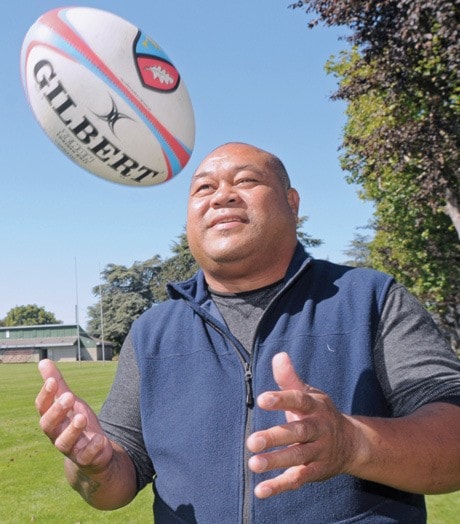No sport puts the Pacific Island nations on the world stage like rugby and nothing in rugby is more iconic than the New Zealand All Blacks’ Haka.
As if playing the world’s No. 1 ranked rugby union team isn’t frightening enough, players of the opposing team are invited to honour the intimidating warrior ritual as a challenge in the final moments leading up to the kickoff.
Canada won its first Rugby World Cup game against Tonga on Tuesday, 25-20, and play France on Sunday (to be aired live at 1 a.m. and replayed at 1 p.m.).
Opposition pundits, particularly from arch-rival Australia, have often debated the fairness of the Haka’s threatening gestures as an advantage in the sports’ macho culture.
But it’s a ceremony, and, as the Canadian players are finding out, a rich part of Pacific Islands’ culture. Plus, New Zealand hasn’t won the Rugby World Cup since hosting the first one in 1987.
The All Blacks are also just one of many nations to use it. Against Tonga the Canadians lined up to witness the Sipi Tau. Just as menacing as the Hakas (the All Blacks use two), the Sipi Tau made headlines on opening day (Sept. 9) as they were performed back-and-forth.
Upon arrival in New Zealand, the Canadian team was greeted with a ceremonial Maori dance. Then during a recent visit to the Bay of Islands College in Kawakawa, teenagers impressed the Canadians with a Haka before sharing in a game of touch rugby. In appreciation, the students from the same school even wrote a new Haka for the Canadians to use.
Joe Fuailefeau, a Samoan who long ago relocated to Victoria and has found a home in the city’s rugby community, said “75 per cent of all entertainment (in many Pacific Island nations) starts with the war dance. It’s not like the war we have nowadays. It’s ceremony.”
Even New Zealand’s ice hockey team performs the Haka.
As a Samoan national rugby player in the early 1980s, Fuailefau performed his country’s version, the Sivi Tau.
He admits there was a time when the pride and ferocity expressed in the war dances carried through into games.
“It was very physical between Tonga and Samoa. Sometimes we only played 25 to 30 minutes until fights ended the game. That has changed now.”
Throughout the RWC, Fuailefeau said he and the local Pacific Island population will root for New Zealand, Tonga, Fiji and Samoa.
And as the father of a national under-17 player, Fuailefeau is just as vested in Canada’s success. His son Michael is now a 20-year-old who graduated from the Castaway-Wanderers and St. Michaels University School youth teams to the University of Victoria Vikes. Michael has also played for Canada’s U17 team and, like dad, wears No. 12 as a centre. Older son Matt recently took up residence on the mainland and will likely visit this season wearing the colours of a new club.
Rees still tops the list
Fly-half Gareth Rees holds the Canadian record for test points with 487. A St. Michaels University School grad and Castaway-Wanderer, Rees’ earned 120 points in the first four World Cups, 1987, 1991, 1995 and 1999. At the start of the tournament on Friday (Sept. 9) his 120 points was 11th of all time, but will likely be passed by a few players this month, including New Zealand’s fly-half Dan Carter.
Ones to watch
During Canada’s test warm-ups with the U.S. and Australian Barbarians no player was as consistently dangerous as DTH Van der Merwe.
The winger is one of four Canadians at the elite level of pro rugby in Europe, playing for the Glasgow Warriors of the RaboBank Pro12. Second rower Jamie Cudmore plays for Clermont Auvergne in France while back rowers Chauncey O’Toole and Jebb Sinclair recently signed to the Ospreys (Wales) and London Irish (England), respectively.
All four cut their teeth in the B.C. Premier League, much like the rest of the Canadian squad.
Starting for Canada against Tonga was scrum-half Ed Fairhurst, a SMUS grad, with Oak Bay High grad Sean White, his replacement on the bench.
Where to watch
The Castaway-Wanderers Rugby Football Club will have Canada’s games on at their clubhouse, 714 Discovery St., as will the Velox Rugby Club at 3957 Gordon Head Rd.
When Canada’s matches fall at 9:30 p.m. on a Tuesday night, like it did this week, you can expect the televisions to be dialed in and the sound turned up at the trio of British-themed pubs the Penny Farthing, Bard & Banker and Irish Times, said manager Mike Boyle.
“We also expect an added element of atmosphere as this time of year a lot of the visiting cruise ship passengers are European,” Boyle said.
Check www.tsn.ca for viewing times on both TSN and TSN2, as well as www.rugbyworldcup.ca for the full schedule.



